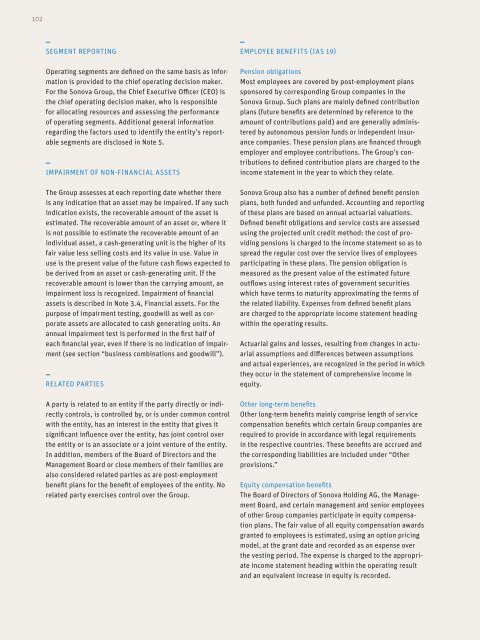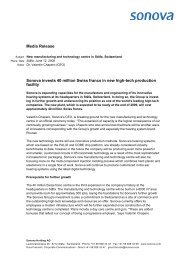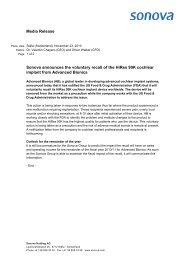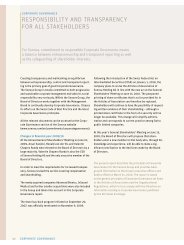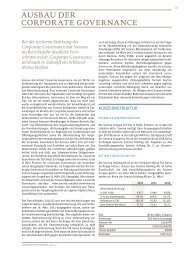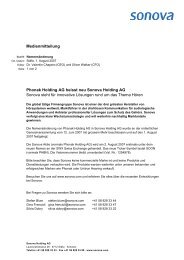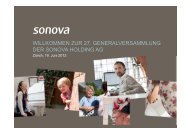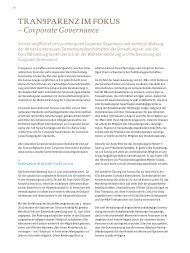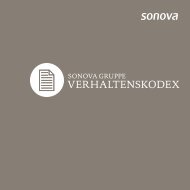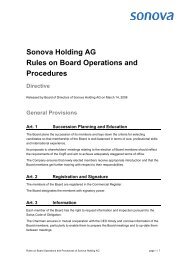Annual Report 2010/11 - Sonova
Annual Report 2010/11 - Sonova
Annual Report 2010/11 - Sonova
Create successful ePaper yourself
Turn your PDF publications into a flip-book with our unique Google optimized e-Paper software.
102<br />
SeGMeNT RePoRTING<br />
operating segments are defined on the same basis as information<br />
is provided to the chief operating decision maker.<br />
For the <strong>Sonova</strong> Group, the Chief executive officer (Ceo) is<br />
the chief operating decision maker, who is responsible<br />
for allocating resources and assessing the performance<br />
of operating segments. Additional general information<br />
regarding the factors used to identify the entity’s reportable<br />
segments are disclosed in Note 5.<br />
IMPAIRMeNT oF NoN-FINANCIAL ASSeTS<br />
The Group assesses at each reporting date whether there<br />
is any indication that an asset may be impaired. If any such<br />
indication exists, the recoverable amount of the asset is<br />
estimated. The recoverable amount of an asset or, where it<br />
is not possible to estimate the recoverable amount of an<br />
individual asset, a cashgenerating unit is the higher of its<br />
fair value less selling costs and its value in use. value in<br />
use is the present value of the future cash flows expected to<br />
be derived from an asset or cash generating unit. If the<br />
recoverable amount is lower than the carrying amount, an<br />
impairment loss is recognized. Impairment of financial<br />
assets is described in Note 3.4, Financial assets. For the<br />
purpose of impairment testing, goodwill as well as corporate<br />
assets are allocated to cash generating units. An<br />
annual impairment test is performed in the first half of<br />
each financial year, even if there is no indication of impairment<br />
(see section “business combinations and goodwill”).<br />
ReLATed PARTIeS<br />
A party is related to an entity if the party directly or indirectly<br />
controls, is controlled by, or is under common control<br />
with the entity, has an interest in the entity that gives it<br />
significant influence over the entity, has joint control over<br />
the entity or is an associate or a joint venture of the entity.<br />
In ad dition, members of the Board of directors and the<br />
Management Board or close members of their families are<br />
also considered related parties as are postemployment<br />
benefit plans for the benefit of employees of the entity. No<br />
related party exercises control over the Group.<br />
eMPLoyee BeNeFITS (IAS 19)<br />
Pension obligations<br />
Most employees are covered by postemployment plans<br />
sponsored by corresponding Group companies in the<br />
<strong>Sonova</strong> Group. Such plans are mainly defined contribution<br />
plans (future benefits are determined by reference to the<br />
amount of contributions paid) and are generally administered<br />
by autonomous pension funds or independent insurance<br />
companies. These pension plans are financed through<br />
employer and employee contributions. The Group’s contributions<br />
to defined contribution plans are charged to the<br />
income statement in the year to which they relate.<br />
<strong>Sonova</strong> Group also has a number of defined benefit pension<br />
plans, both funded and unfunded. Ac counting and reporting<br />
of these plans are based on annual actuarial valuations.<br />
defined benefit ob ligations and service costs are assessed<br />
using the projected unit credit method: the cost of providing<br />
pensions is charged to the income statement so as to<br />
spread the regular cost over the service lives of employees<br />
participating in these plans. The pension obligation is<br />
measured as the present value of the estimated future<br />
outflows using interest rates of government securities<br />
which have terms to ma turity approxi mating the terms of<br />
the related liability. expenses from defined benefit plans<br />
are charged to the appropriate income statement heading<br />
within the operating results.<br />
Actuarial gains and losses, resulting from changes in actuarial<br />
assumptions and differences between assumptions<br />
and actual experiences, are recognized in the period in which<br />
they occur in the statement of comprehensive income in<br />
equity.<br />
other longterm benefits<br />
other longterm benefits mainly comprise length of service<br />
compensation benefits which certain Group companies are<br />
required to provide in accordance with legal requirements<br />
in the respective countries. These benefits are accrued and<br />
the corresponding liabilities are included under “other<br />
provisions.”<br />
equity compensation benefits<br />
The Board of directors of <strong>Sonova</strong> Holding AG, the Management<br />
Board, and certain management and senior employees<br />
of other Group companies participate in equity compensation<br />
plans. The fair value of all equity compensation awards<br />
granted to employees is estimated, using an option pricing<br />
model, at the grant date and recorded as an expense over<br />
the vesting period. The expense is charged to the appropriate<br />
income statement heading within the operating result<br />
and an equivalent increase in equity is recorded.


